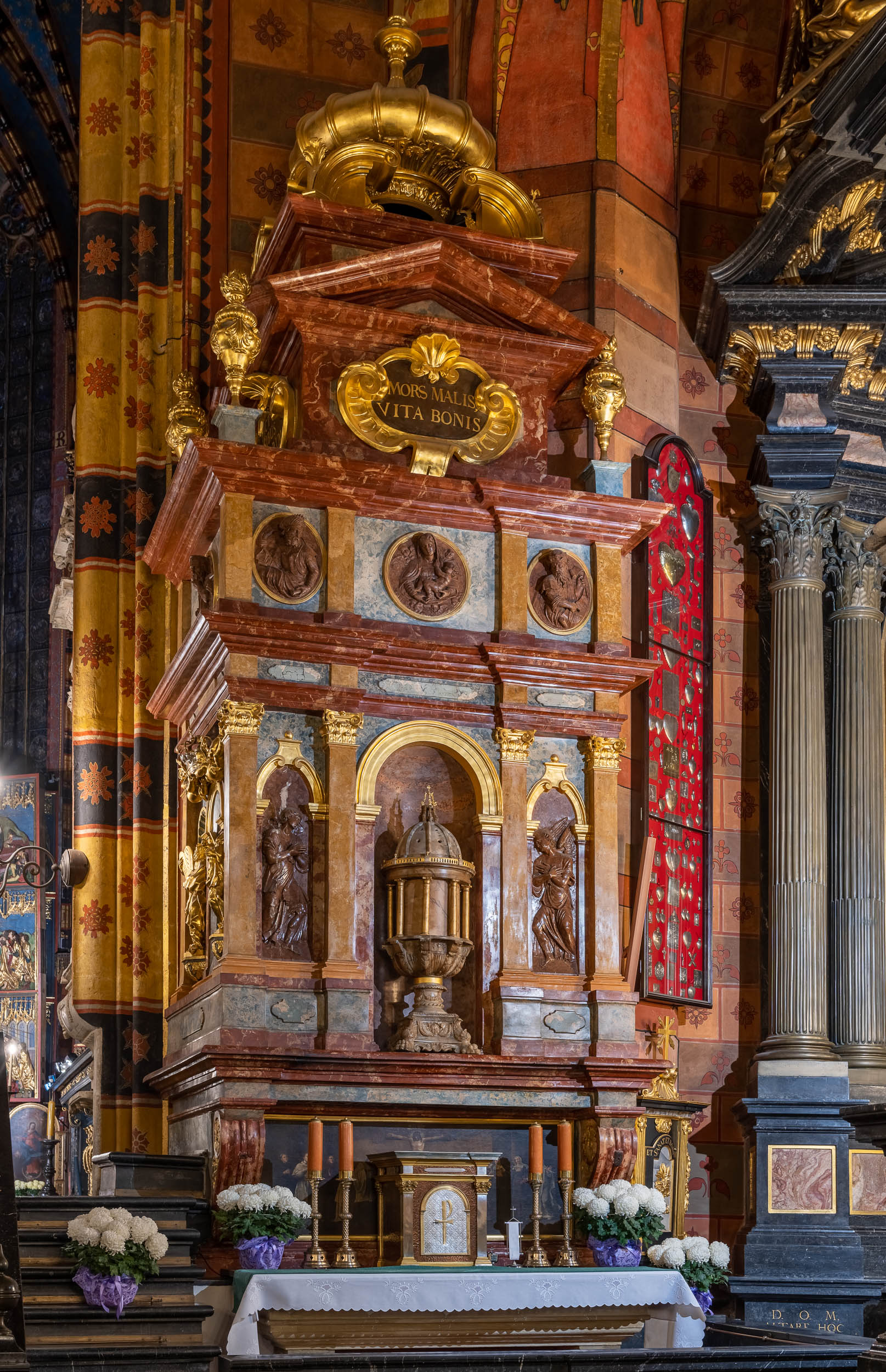
Cyborium
- Subject
- Cyborium
- Contributor
- -
- Style
- Renesans
- Date
- 1551-1554
- Type
- Ołtarz cyborialny
- Material and technique
- Marmur czerwony i żółty, stiuk i alabaster, srebro, drewno złocone
- Size
- Brak danych
- Signatures and inscriptions
- Kartusze: Factus cibus viatorum, Mors malis vita bonis
- Identity number
- -
- Department
- -
- Links/analogies
- Nakrywająca tempietto kopułka z latarnią wyraźnie nawiązuje do sławnej kopuły katedry S. Maria del Fiore we Florencji, dzieła Filippa Bruneleschiego. (Walczak, Czyżewski, Kościół Mariacki w Krakowie. 800 lat historii, Kraków 2023)
- Owner
- Bazylika Mariacka w Krakowie
- Copyright
- Bazylika Mariacka w Krakowie
- Location
- Nawa główna, strona południowa
- Description
- The Renaissance ciborium in the shape of a central shrine suspended on consoles above the altar mensa was realised between 1551 and 1554 by the eminent Italian architect and sculptor Giovanni Maria Mosca, called Padovano, commissioned by George Pipan and Andrew Marstella, using a bequest from the will of Thomas Penczberger. The author's talent and importance is evidenced by the fact that, prior to his arrival in Poland, he had worked, among other things, on the decoration of the famous St Anthony's Chapel in the Basilica Il Santo in Padua. In Kraków, the artist realised the Eucharistic altarpiece in the cathedral, commissioned by Bishop Piotr Tomicki. The St Mary's ciborium surpassed it both in size and elaborate sculptural decoration. The base of the altar features a medallion with a paschal lamb symbolising Jesus with a resurrection flag. On the front wall, in a niche, there is a tempietto adored by a pair of angels, i.e. a round miniature shrine supported on an elaborate base, carved from alabaster and gilded in places. In the upper part of the altar settee, tondos with busts of the Virgin and Child, and the Old Testament kings David and Solomon and the prophet Jeremiah, carved in red marble, are arranged in the attic. The sculptures are distinguished by their elegance and excellent workmanship. The Renaissance ciborium altar was transformed in the mid-18th century, when its walls and architectural divisions were covered with imitation coloured red and greenish marbles and crowned, surrounded by volute-wrapped sections of interrupted abutments with a striking onion-shaped cupola. The slender flame vases and cartouches with inscriptions date from the same time: Factus cibus viatorum (A meal is made for wanderers), Mors malis vita bonis (Death to the bad, life to the good), taken from the Latin sequence Lauda Sion Salvatorem written by St Thomas Aquinas for the feast of Corpus Christi. At about the same time, a large rococo silver lamp was hung in front of the altar, still burning today in honour of Christ hidden in the Blessed Sacrament. In the predella of the altar settee, a painting by Lukasz Orlowski was inserted in 1762, showing Christ on the cross (modelled on St Mary's crucifix by Veit Stoss) adored by Polish saints and blesseds. The alabaster tempietto has only a symbolic function, as the actual place where the Eucharist is kept is to the side, and is accessed by a staircase with a bronze and marble balustrade. The silver door of the tabernacle is marked with the image of a chalice and set in a perspective niche. At the sides stand figures and above them two angels holding a crown, all in gilt wood.